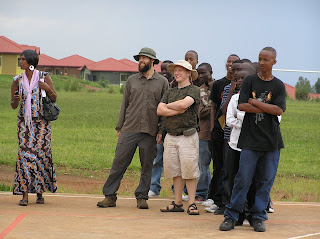From the top of our hill, Lake Mugesera and the swamp appears to be just a short walk away. Six kilometers later, you look back, and realize that the six kilometers back are uphill. Fortunately, the wildlife is worth it.
 |
| Welcome to the swamp! |
There are several routes one can take to reach the lake. Sometimes great birds are found along the way; sometimes hordes of children swarm a few meters behind you. Whatever the route, although it is only 5km to the lake as the crow flies, your path will wind at least 6km past farms, homes, and through swamp.
 |
| Swamp-jumping! We have yet to have a full fall-in. If that happens, we'll definitely get pictures! |
The swamp that fringes Lake Mugesera is actually much better for spotting wildlife than the lake itself. We have seen only around four species on the lake water in five trips, but dozens live in the swamp.
 |
| The muck and water can past your knees. Expect to get a little wet. |
Much of the swamp has been cleared and cultivated (rice is a major crop in former swamps). Local residents harvest the papyrus and use it to cover soil to prevent unwanted plants from growing. Still, some native vegetation remains.
 |
| Papyrus dominates the swamp. What lives inside is a mystery unless you are lucky enough to have something pop out. |
Patience is required at the swamp. Some spots hardly even afford a view. The potential in a swamp is high, but at the same time, you may walk away with seeing only common species.
 |
| Hadada ibis (Bostrychia hagedesh) forage among the swamp grasses. They are one of three ibis species found in Rwanda. |
We have yet to find any of the regional papyrus-endemic species in our local swamp (endemic means that a species is unique to some area, whether it be a habitat type or region). However, if we do find one, it would be quite the treasure. Shoebills, papyrus gonoleks, papyrus canaries, Carruther's cisticolas, and white-winged warblers are all known to live in swamps in Rwanda.
 |
| Find the bittern! Clue: look for its outstretched neck. |
The allure of the swamp is mainly different birds than we are used to seeing. Every once in a while, we find a species new to us. Our swamp is the only place we have seen little bitterns, cape wagtails, northern brown-throated weavers, and slender-billed weavers.
 |
| The little bittern (Ixobrychus sturmii) is spectacular bird, and we believe there is a pair nesting in this piece of swamp (we have seen them in the same spots over a three-month period). |
There are plenty of butterflies and dragonflies that dazzle along. Sometimes frogs jump from the side and plop into the watery muck of the swamp. We have yet to see any snakes, but this is a habitat where several species could thrive. Locals say there are no crocodiles, and our observations confirm that. People have told us that hippos and elephants used to live here- can you imagine looking down from the hill and seeing elephants?
 |
| We found a troop of twelve gentile blue monkeys (Cercopithecus species) traversing the swamp. They came out on the opposite side to raid some banana trees. |
If you are interested in seeing the swamp and the lake near where Michele and I live, plug in these coordinates to Google Earth or another similar program: Latitude: 2° 4'13.31"S Longitude: 30°22'5.07"E. That spot is a small cove surrounded by swamp that is favored by both human residents for water and by birds for its prominent perches and abundant food. You can see the swamp (full of small squares that are now cultivated) going north until it forms the top of a "Y." Welcome to the local swamp!
 |
| The pied kingfisher (Ceryle rudis) is a widespread species that is very easily seen at the swamp and hovering over the lake. |
 |
| The sacred ibis (Threskiornis aethiopicus) stands here on some cropland just outside the swamp. It is generally looks for macroinvertebrates and snatches them with its long, curved bill. |
 |
| The black-headed gonolek (Laniarius erythrogaster) is a brilliant-looking bird. Jet black on the head, back and wings with a blood-red throat and belly, it is always a pleasure to see. |
 |
| The swamp flycatcher (Muscicapa aquatica) is only found around, you guessed it, swamps and lakeside vegetation. |
 |
| Swamp creatures! |










